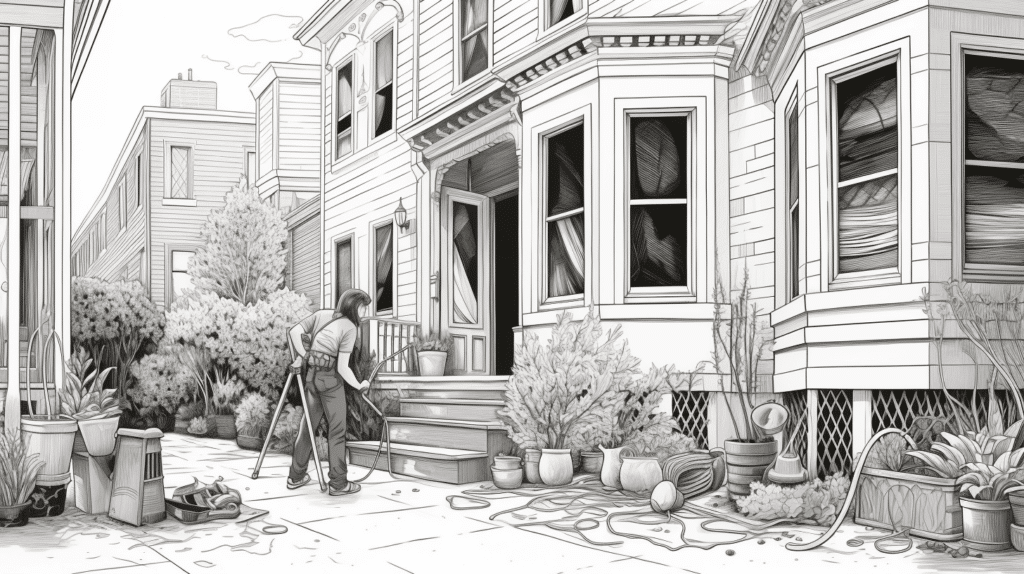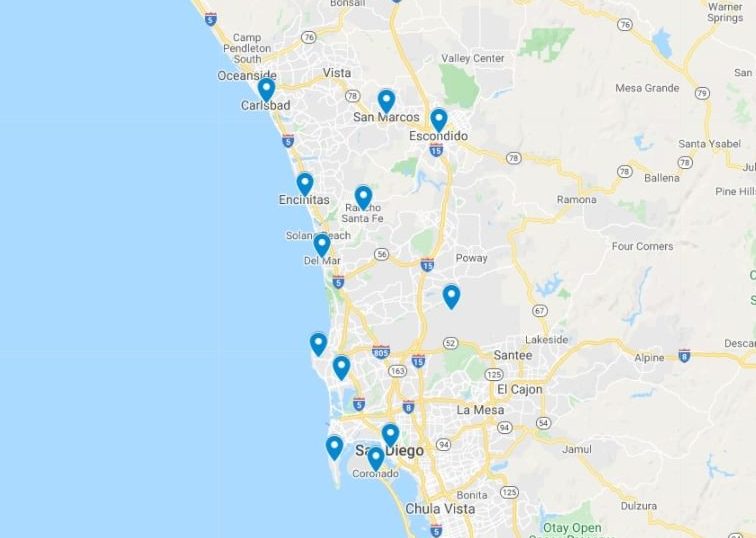The exterior of your home is the first thing people notice, and it often sets the mood for what to expect inside. Thus, keeping your outdoors clean and well-maintained is equally as important as doing the same indoors. However, outdoor cleaning takes a different set of techniques and equipment, simply because the outdoors face different types of dirt and exposure. In this article, we’ll guide you through various methods of outdoor cleaning for different areas around your home – from driveways and gutters to roofs and lawn. Not only this, we’ll shine a light on the safety precautions you should never overlook. Once you get the hang of these cleaning techniques, you’ll see that it’s not as daunting as it seems! Let’s redefine ‘clean’!
Driveway Cleaning Techniques
Cleaning your driveway is more than a simple aesthetic exercise. It’s an essential maintenance practice that boosts your home’s curb appeal, prolongs the lifespan of your driveway, and eliminates potentially hazardous growths. In this section, we delve into three proven driveway cleaning techniques that will leave your driveway sparkling: pressure washing, chemical cleaning, and sealant application.
Pressure Washing
The first technique in our list is pressure washing, acclaimed for its effectiveness and speed. It employs high-pressure water spray to eliminate dirt, grime, mold, and other stubborn stains your driveway might have endured throughout the seasons.
Here’s how to go about it:
- Begin by clearing your driveway of any debris or objects.
- Once done, connect your pressure washer to a water source.
- If needed, pre-treat the driveway by applying a detergent solution, starting from the lowest point to the top.
- Set your pressure washer to a suitable setting, usually medium, and power it on.
- Clean from top down in an even sweeping motion, keeping the nozzle about a foot away from the surface.
Remember: Pressure washing can be abrasive, thus not suitable for all driveway materials. Always consult with the manufacturer’s guide to see if pressure washing is recommended for the type of driveway you have.
Chemical Cleaning
Next on the list is chemical cleaning. This method often utilizes biodegradable degreasers and cleaners that, when applied correctly, can break down and remove even the most stubborn driveway stains.
Here are the steps to follow:
- Start by wetting the driveway to prevent the cleaner from drying out too quickly.
- Apply the degreaser from the bottom up, trying to cover as much area as possible, and let it rest for a few minutes.
- Using a scrubbing brush with stiff bristles, scrub the areas with stains.
- Rinse thoroughly from the top towards the bottom to ensure all the degreaser and dissolved stains are completely washed away.
Note: While most cleaners are eco-friendly, some contain harsh chemicals. Always handle them with care and avoid getting into contact with your skin or eyes.
Sealant Application
Lastly, you might consider sealing your driveway after cleaning it. A quality sealant can protect your driveway from harsh weather, UV rays, oil stains, and water damage. Here’s the typical process:
- Start by ensuring your driveway is well cleaned and completely dry.
- Apply the sealant using a squeegee or a specialized sprayer, making sure to cover all areas.
- Allow the sealant to dry fully before using your driveway again. This might take anywhere from 24 to 48 hours, depending on the product you use.
Sealant application is the final touch that not only enhances your driveway’s appearance but also extends its lifespan. It’s advisable to reseal your driveway every two to three years, depending on its usage and exposure to the elements.
In summary, a clean, well-maintained driveway not only elevates your home’s exterior aesthetics but also safeguards your investment in the long run. Choose a cleaning method that best suits your driveway material and personal preference. Whether you choose pressure washing, chemical cleaning, or sealant application, your driveway can maintain its pristine appearance and functionality for years to come.
Gutter Cleaning Techniques
Maybe you’ve never given it much thought, but maintaining clean gutters is pivotal for every homeowner. It’s one of those home maintenance tasks that gets easily overlooked but plays an essential role in protecting your home. This article will guide you through the various gutter cleaning techniques. If you’re wondering how to undertake, look no further. We’ll break down the cleaning process into three main categories: Manual Cleaning, Use of Cleaning Tools, and Preventive Measures.
Lawn Cleaning Techniques
Keeping your lawn clean and trimmed gives it an appealing look. It also contributes significantly to your home’s visual appeal, significantly impacting its value. Lawn Cleaning involves several processes: manual cleaning, lawn mowing, leaf collection, lawn aeration, and lawn fertilization. This section will dive into these techniques one by one, providing you with in-depth knowledge about how each step contributes to the overall health and beauty of your lawn.
Manual Cleaning
Manual cleaning mainly involves removing debris, including fallen branches, rocks, and rubbish that may have ended up on your lawn. It provides room for grass to grow uniformly, without the impediments blocking the light and intruding on the space they need to thrive. Here are few benefits of manual cleaning:
- Enhances the appearance of your lawn
- Prevents the growth of harmful bacteria and fungi
- Increases the longevity of your lawn mower by reducing the risk of it hitting hard debris and getting damaged
Lawn Mowing
Mowing is a vital aspect of lawn care because it helps keep your grass healthy and lush. Regular trimming discourages weeds from sprouting and spreading, promoting uniform grass growth. Mowing at the correct height also encourages the growth of healthy roots, leading to a more robust lawn withstand drought conditions. It’s essential to keep your mower blade sharp for clean cuts, which reduces the stress on the grass.
Leaf Collection
During autumn, your lawn can be covered with fallen leaves, which, if left untreated, can smother your grass, blocking the essential sunlight and nutrients they need to survive the cold winter months. Leaf collection can be done either by raking manually or using a leaf blower. Composting leaves can provide a wealth of nutrients for your lawn once the compost is ready.
Lawn Aeration
Lawn aeration is a process that involves perforating soil with small holes to allow water, air, and nutrients to penetrate the grassroots. Aeration helps to reduce soil compaction, which can seriously hinder the health and growth of your lawn grass. Over time, the soil gets compact, making it difficult for roots to expand. Aeration relieves this pressure, creating space for roots to breathe and absorb nutrients effectively.
Lawn Fertilization
Fertilization provides the nutrients your lawn needs to stay green, healthy, and thriving. Not all soils are created equal, and most do not provide the necessary nutrients for optimal growth. A professional lawn care service can test your soil and determine what type of fertilizer is needed. Regular fertilization can turn a thin, struggling lawn into a lush, green oasis.
Maintaining a splendid lawn may not be as easy as it sounds, especially for those new to lawn cleaning and care. However, with patience, appropriate techniques, and continuous learning, the process becomes less daunting, and you’ll soon be on your way to enjoying a beautifully landscaped lawn that not only enhances your home’s curb appeal but also creates an inviting space for outdoor activities.
Roof Cleaning Techniques
Your roof protects you and your loved ones from the harsh natural elements. Over time, that shield becomes a magnet for dirt, leaves, stubborn moss, and algae, dulling the initial radiant hue of your roof and potentially causing damage. But fear not, we are here to arm you with the best roof cleaning techniques that will help you restore and maintain the beauty and functionality of your roof.
These techniques include:
- Pressure Washing
- Chemical Cleaning
- Protective Measures
Exterior Walls Cleaning Techniques
Nature doesn’t always play nice with the exteriors of our homes or offices. Whether it’s harsh weather, dust, or even the simple passage of time, grime can easily accumulate on your exterior walls, making them appear dingy and aged. Luckily, this is where exterior cleaning techniques come into play. Let’s explore some of the most effective methods: pressure washing, hand washing, and chemical cleaning.
Pressure Washing
Pressure washing is a popular and efficient technique used to clean exterior surfaces. It utilizes a high-pressure water spray to remove accumulated dirt, mildew, and even peeling paint. Pressure washing can bring amazing results on surfaces such as concrete, brick, and vinyl siding.
Pros of Pressure Washing:
- Fast and efficient: It covers a larger area in a shorter amount of time compared to other methods.
- Eco-friendly: Doesn’t rely on harsh chemicals.
Cons of Pressure Washing:
- Potential damage: If not handled properly, the high pressure can damage the surface.
- Limited use: Not recommended for delicate surfaces like stucco or aged wood.
Hand Washing
When dealing with delicate areas that may be more susceptible to damage, hand washing is a great alternative. This involves manually scrubbing the surface with a brush and cleaning solution. Its delicate approach ensures no surface damage.
Pros of Hand Washing:
- Point specific cleaning: Targets specific areas on your wall with higher precision.
- Safer: Minimal risk of accidental damage to your property.
Cons of Hand Washing:
- Time-intensive: Takes longer than other methods.
- Physical effort: Requires more physical labor.
Chemical Cleaning
Chemical cleaning involves using particular solvents to eliminate stubborn stains or residue that are hard to remove with pressure or hand washing. Different solutions are used based on the type and extent of dirt.
Pros of Chemical Cleaning:
- Effective on stubborn stains: Can handle tough-to-clean spots that other methods can’t.
- Time-saving: Requires less time as compared to hand washing.
Cons of Chemical Cleaning:
- Potential harm: Some chemicals might harm the environment or fade the wall’s color.
- Safety concerns: Requires safety measures to prevent potential harm to your skin or eyes.
Choosing the right cleaning technique for your exterior walls can significantly impact their appearance and longevity. Each method has its pros and cons, so it’s important to analyze the condition of your walls and the type of dirt you’re dealing with before making a decision. Remember, a clean exterior not just enhances the building aesthetically, but also contributes to its overall upkeep and value.
Outdoor Furniture Cleaning Techniques
Cleaning your outdoor furniture not only maintains its appearance but also prolongs its life. Depending on the material and level of dirt, furniture cleaning techniques may vary. Understanding the right methods to apply can make a huge difference in your furniture maintenance routine. In this article, we will explore three techniques: hand cleaning, pressure washing, and the use of cleaning agents.
Hand Cleaning
Hand cleaning is a simple yet effective method to clean your outdoor furniture. This technique involves using a soft brush, mild detergent, and warm water to gently brush off dirt and debris from the surface. Here’s how to do it:
- First, fill a bucket with warm water and add a few drops of mild detergent.
- Take a soft brush and dip it into the solution. Gently scrub the furniture, paying particular attention to corners and under surfaces where dirt often accumulates.
- Rinse the furniture thoroughly with clean water and allow it to dry under the sun.
Remember to test the detergent on a small, inconspicuous area first to ensure it doesn’t damage the furniture’s material. Also, it’s advised to not use bleach as it could discolor your furniture.
Pressure Washing
Another efficient method for outdoor furniture cleaning is pressure washing. This technique applies for durable materials such as metal, plastic, teak, and wrought iron. It involves directing a high-pressure water spray to remove stubborn dirt, mildew, and other grime.
However, not all furniture can endure pressure washing. For instance, soft woods, like pine or cedar, and rattan may get damaged with high-pressure washing. Therefore, always check the material and manufacturer’s instructions before proceeding.
Use of Cleaning Agents
For deeply stained or mildewed furniture, cleaning agents can come to your rescue. Many commercial cleaning agents can effectively clean and restore the original look of your outdoor furniture. Some popular cleaning agents include vinegar-based solutions (for mild stains), spirit-based solutions (for heavier stains), and specially formulated outdoor furniture cleaners available in the market.
Remember to follow the instructions given on the product labels. For safety reasons, use gloves and protective eye gear while handling chemical cleaning agents to avoid skin and eye irritations.
Practicing good maintenance habits and knowing the correct cleaning techniques can greatly increase the lifespan and aesthetic appeal of your outdoor furniture. By implementing these effective cleaning strategies – hand cleaning, pressure washing, and the use of cleaning agents – you can keep your outdoor ensemble looking its best and ready for entertaining whenever needed.
Safety Precautions when Cleaning Outdoors
Anyone who owns outdoor space can agree on one thing: maintenance can be quite a task to deal with. However, being informed of the correct safety measures to deploy during these cleaning operations can simplify the process exponentially. This article aims to provide insightful content on safety precautions you should take when cleaning outdoors, focusing on three key areas: protection wear, suitable cleaning agents, and proper tool handling practices.
Protection Wear
Feeling the sun on your skin while you tend to your outdoor space can be exhilarating. But donning protective clothing is a necessity that should never be overlooked. Here’s why:
- Sun Protection: Long hours under the sun can expose your skin to harmful UV rays. Opting for UV-resistant clothing and sunscreen can shield you from potential skin damage.
- Preventing Injuries: Gloves can shield your hands from errant thorns, splinters, and rough textures that could cause injury.
- Eye Protection: Goggles prevent particles and liquids from entering your eyes during tasks like mowing or power washing.
It’s important to choose gear that not only protects you but also ensures you’re comfortable during the cleaning process.
Suitable Cleaning Agents
Using the right cleaning agents not only ensures efficient cleaning but also keeps you safe during the operation. Here are a few points to consider:
- Eco-friendly Products: These products are not only good for the environment, but they also reduce the risk of skin and respiratory irritation.
- Label Instructions: Always follow the instructions provided on the cleaning agent labels. They provide guidelines on safe usage and what to do in case of accidental ingestion or contact with skin and eyes.
Moreover, always remember to store cleaning agents safely out of reach of children and pets.
Proper Handling of Tools
The right tool handling practices can go a long way in preventing mishaps during cleaning operations. Keep these aspects in mind:
- Tool Maintenance: Regular tool maintenance ensures their safe and efficient operation. This includes sharpening for tools like gardening shears and lawnmower blades.
- Proper Tool Usage: Using each tool as it is designed to be used prevents injuries and damage to your outdoor space.
- Safe Storage: Tools should be stored in a dry and secure location to prevent accidents and prolong their lifespan.
Taking the time to familiarize yourself with your tools and maintenance practices can enhance your cleaning experience while ensuring your safety.
In the realm of outdoor cleaning, your safety should always come first. Armoring yourself with appropriate protection wear, choosing suitable cleaning agents, and handling your tools properly are three pillars on which a safe and efficient cleaning operation stands. With these safety precautions in mind, you’re more than ready to transform your outdoor space into a clean, aesthetically pleasing haven.
Conclusion
Keeping your home’s exterior clean shouldn’t feel like an insurmountable task. By employing the right cleaning techniques, maintaining all outdoor areas—from the roof to the driveway—can be manageable and even rewarding. Remember, a clean exterior not only enhances the visual appeal of your property but also increases your home’s value.
In cases where specialized cleaning is required, or if you simply don’t have enough time, consider hiring professionals to provide a thorough and careful cleaning. At Ascension Home Services, we are committed to making your home shine with a range of expert cleaning services. From roof and gutter cleaning to power washing, and even holiday light installation—our experienced team is equipped to take care of your home’s maintenance needs. Visit our website to learn more about our customizable service offerings.
Through careful planning, strategic cleaning techniques, and understanding the value of professional help when necessary, your home will not only look its best but also serve as a healthy, clean sanctuary for you and your family. Here’s to a cleaner, brighter home!
Frequently Asked Questions
- What are some effective techniques for cleaning the outside of my home?Some effective techniques for cleaning the outside of your home include pressure washing, using a mixture of water and bleach for mold and mildew removal, scrubbing with a long-handled brush, and using eco-friendly cleaning solutions.
- How often should I clean the exterior of my house?The frequency of cleaning the exterior of your house depends on various factors such as the climate, pollution levels, and the presence of trees or plants near your home. Generally, it is recommended to clean the exterior at least once a year, preferably in the spring or early summer.
- Can I use a pressure washer to clean all types of surfaces?No, it is important to use a pressure washer with caution as it can damage certain surfaces. Avoid using high-pressure settings on delicate materials such as wood or stucco. It is best to refer to the manufacturer’s guidelines or seek professional advice for specific surfaces.
- Are there any eco-friendly cleaning solutions for outdoor cleaning?Yes, there are eco-friendly alternatives available for outdoor cleaning. Natural ingredients like vinegar, baking soda, and lemon juice can be used to create effective cleaning solutions that are safe for the environment.
- Should I hire a professional for outdoor cleaning tasks?While it is possible to do outdoor cleaning tasks yourself, hiring a professional can ensure a thorough and efficient cleaning. Professionals have the necessary equipment, expertise, and knowledge to safely clean various surfaces without causing damage.












